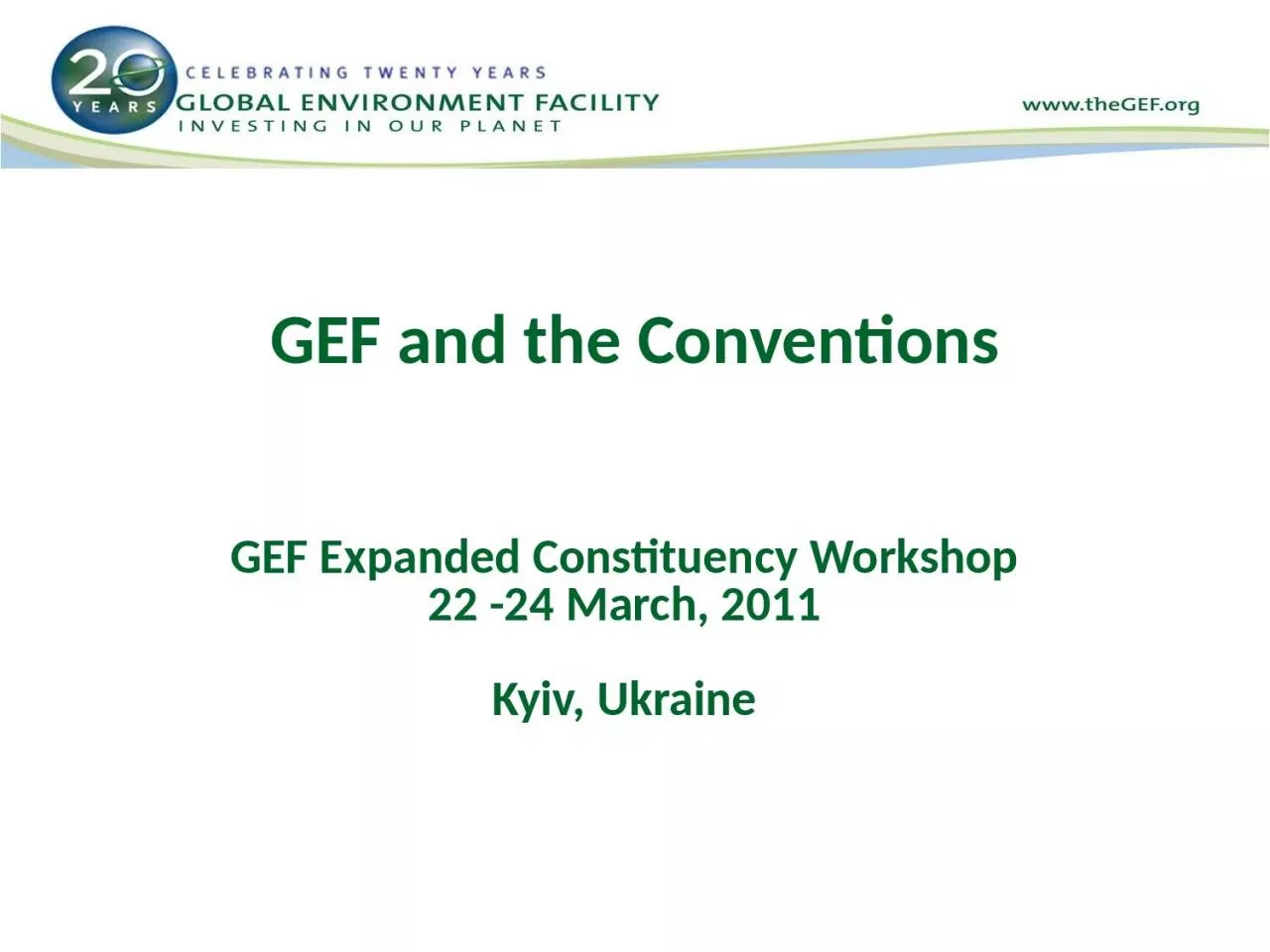

22 24 March 2011 Kyiv Ukraine GEF and the conventions The GEF provides funding to assist developing countries in meeting the objectives of international environmental conventions The GEF serves as financial mechanism for four conventions ID: 1026511
Download Presentation The PPT/PDF document "GEF and the Conventions GEF Expanded Con..." is the property of its rightful owner. Permission is granted to download and print the materials on this web site for personal, non-commercial use only, and to display it on your personal computer provided you do not modify the materials and that you retain all copyright notices contained in the materials. By downloading content from our website, you accept the terms of this agreement.
1. GEF and the ConventionsGEF Expanded Constituency Workshop22 -24 March, 2011Kyiv, Ukraine
2. GEF and the conventionsThe GEF provides funding to assist developing countries in meeting the objectives of international environmental conventions. The GEF serves as "financial mechanism" for four conventions:The Convention on Biological Diversity The United Nations Framework Convention on Climate Change The United Nations Convention to Combat Desertification The Stockholm Convention on Persistent Organic Pollutants
3. Biodiversity Focal Area Strategy and CBD COP GuidanceCOP 2010-2014 Programme Priorities GEF-5 Strategy Objectives Programme priority area 1: Promote conservation of biological diversity, including through catalyzing sustainability of protected area systems Programme priority area 2: Promote sustainable use of biodiversity Objective One: Improve Sustainability of Protected Area SystemsProgramme priority area 2: Promote sustainable use of biodiversityProgramme priority area 3: Mainstream biological diversity into various national sectoral policies development strategies programsObjective Two: Mainstream Biodiversity Conservation Sustainable Use into Production Landscapes/Seascapes SectorsProgramme priority area 4: Improve national capacity to implement the Convention and the Cartagena Protocol on BiosafetyObjectives One and Two as above, Objective Four: Build Capacity on Access to Genetic Resources and Benefit SharingObjective Five: Integrate CBD Obligations into National Planning Processes through Enabling Activities. Objective Three: Build Capacity for the Implementation of the Cartagena Protocol on Biosafety
4. Biodiversity Focal Area Strategy and CBD COP GuidanceCOP 2010-2014 Programme Priorities GEF-5 Strategy Objectives Programme priority area 5: Promote the implementation of the Convention’s third objective support the implementation of the international regime on access to genetic resources benefit‑sharing Objective Four: Build Capacity on Access to Genetic Resources Benefit SharingProgramme priority area 6: Safeguard biodiversityObjective Two: Mainstream Biodiversity Sustainable Use into Production Landscapes Seascapes Sectors Objective One: Improve Sustainability of Protected Area Systems: c) Improve management effectiveness of existing protected areas Objective Three: Build Capacity for the Implementation of the Cartagena Protocol on Biosafety
5. Climate Change Focal Area Strategy and UNFCCC COP GuidanceIn response to Convention guidance, the GEF has provided financial and technical support to more than 150 non-Annex I Parties to prepare their initial, second, and, in some cases, third national communications to the Convention. During GEF-3, the GEF funded a global program to support the second national communications of most eligible countries. During GEF-5, the GEF will continue to provide finance for national communicationsIn response to COP decision 2/CP.12, the GEF launched a strategic program during GEF-4 to promote the reduction of GHG emissions from Land Use, Land-Use Change and Forestry (LULUCF) within the climate change focal area. In GEF-5, the GEF has established the cross-cutting initiative of Sustainable Forest Management (SFM). At COP13, the GEF was requested to elaborate a strategic program to scale up the level of investment in technology transfer to help developing countries address their needs for environmentally sound technologies – GEF established the Poznan Strategic Program on Technology Transfer
6. Climate Change Adaptation Strategy and UNFCCC COP GuidanceAt COP7 in 2001, the UNFCCC asked the GEF to finance adaptation pilot and demonstration projects. The GEF establish the Strategic Priority on Adaptation (SPA) during GEF-3/GEF-4 under the GEF trust fund in response to guidance from the COP. (e.g. decision 5/CP.7)COP7 asked the GEF to manage two voluntary adaptation-focused funds, the Least Developed Countries Fund (LDCF) and the Special Climate Change Fund (SCCF); The GEF is continuing to fundraise and replenish the LDCF and SCCF in response to Convention guidance and conclusions of the subsidiary bodies of the UNFCCC, (e.g. at the 26th session of the SBI)The conclusions at SBI 31 have recognized the steps the GEF has taken to enhance the support of the implementation of NAPAs
7. Land Degradation Focal Area Strategy and UNCCD COP GuidanceAs a new UNCCD financial mechanism, the GEF is currently clarifying how its land degradation focal area strategy will directly contribute to implementation of the UNCCD, including its ten-year (2008–2018) Strategic Plan and Framework adopted by the eighth COP. When developing the latest strategy for the land degradation focal area, the Technical Advisory Group (TAG) included a representative of the UNCCD, who provided guidance as the TAG explicitly sought to accept the COP’s invitation to the GEF to take into account this ten year strategic plan and to align its operations accordingly in order to facilitate effective implementation of the Convention
8. POPS Focal Area Strategy and Stockholm Convention GuidanceThe GEF POPs strategy responds to guidance adopted by the COP to the Stockholm Convention at its first four meetings.The latest guidance adopted by the COP at its fourth meeting in May 2009 reaffirms the central guiding principle that the GEF should “take into account the priorities identified by Parties in their implementation plans transmitted to the Conference of the Parties”, and further highlights the preparation and update of NIPs, alternatives to DDT for disease vector control, and information exchange.The GEF’s mandate as financial mechanism of the Stockholm Convention will require addressing the newly listed chemicals under the Convention.
9. Enabling ActivitiesFocal AreaMaximum GrantPurposeBiodiversity$500,000 USDReport to Convention on Biodiversity and Biosafety and National Biosafety Strategies and Action Plans (NBSAPs)Climate Change$500,000 USDNational CommunicationsLDCF$200,000 USDNational Adaptation Programme of Action (NAPA)Land Degredation$150,000 USDCan be used for alignment of NAPs and country strategies with the UNCCD 10 year strategyChemicals$250,000 USDPrepare and update NIPs
10. Direct Access Grants for Convention Reports: Activity Implementation Process
11. Thank you